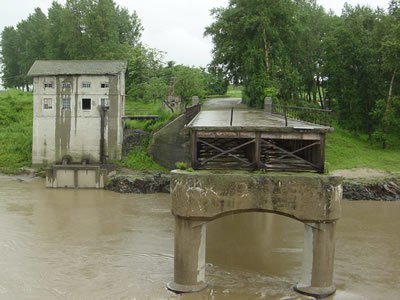Because I design Web sites, I often have to spend time combing through lists and lists of photographs looking for the one that will make a site look just right. There is an incredible variety of photos available out there. I generally try to stick with iStockphoto because their prices are so reasonable, but sometimes also look through the lists from some other sellers.
Yesterday I was looking for a picture of a bridge, and in my travels came across a picture that really got me thinking, because it seemed to be such a great illustration of a doctrine I hold dear. Observe, if you will, the following picture:

It is a picture of a bridge. To elaborate a little bit, we could say that it is a partial bridge. It doesn’t look broken, as if a piece of it fell away, but rather looks like it was built that far and then work simply ceased. It spans about half of what appears to be a pretty sizeable river and then just ends (or begins, depending which direction you approach it from). I have no idea where this bridge is, what the circumstances are surrounding it’s state or if it has a name. But if I had to name it I would call it the Bridge of Conditional Universalism. I bet you weren’te expecting that, were you? Let’s make a metaphor out of this bridge. Consider this river for a moment and let it represent the chasm between God and man – the chasm created by man’s fall into sin. On the bank of the river stands a man who represents humans in their fallen state, living on this earth. He gazes across the gap to the far side where he can glimpse God, and glimpse heaven. Now how will he get to heaven?
At this point you may have concluded that I didn’t get enough sleep last night or that I had some sour milk on my Corn Flakes, but hear me out. This bridge seems to me to be a great illustration of a doctrine known as “unlimited atonement” or “conditional universalism.” This is one of the doctrines associated with Arminianism, and it states that it was never God’s will to save any specific person. Rather, it was God’s will to do all He could to save all men, provided they would do the little bit that He could not. In other words, the death of Christ erected this bridge which extends across part of the chasm. Man need only swim out into the current and hoist himself onto the bridge. From there he can walk safely into heaven. And if you look again you will see that this is a wide bridge, able to carry many people. This bridge is wide enough for anyone, but extends only part of the way.
Now consider a second bridge, the Bridge of Particular Redemption.

This bridge is quite a bit different from the last. Notice that rather than extending only halfway, this one extends from one bank to the other. Notice also that it is narrow, much narrower than the other. This bridge represents the doctrine associated with Calvinism that we know as Limited Atonement or Particular Redemption. This bridge spans the entire gap between God and man, though is not so wide as to carry all men, but only some. Where the first bridge was able to carry all men part of the way, this bridge carries some men the entire way.
Hebrews 12:2 tells us that Jesus is the “founder and perfecter of our faith.” He not only began but also finished the bridge. With His blood He “ransomed people for God from every tribe and language and people and nation,” (Revelation 5:9) not merely providing the potential for their redemption, but effectually redeeming them when He cried out “It is finished!”










